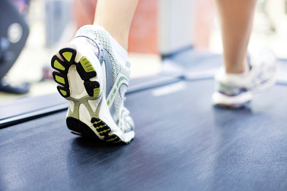To prescribe exercise, start specific and small
Primary care physicians can offer more specific advice when they suggest exercise##mdash;frequency, intensity and type, for example##mdash;to increase their patients' likelihood of following through.
Research is showing that exercise is as effective as medication for prevention of medical problems such as diabetes and repeat myocardial infarctions, but physicians don't treat it like a drug, according to Christopher Bunt, MD, assistant professor at the Uniformed Services University of the Health Sciences in Bethesda, Md.
“When we prescribe medication, we don't just say, ‘Here's x pill. Have a nice day.’ We tell them what dose to take. We tell them how often to take it. We hopefully tell them how long they're going to be on it,” Dr. Bunt told attendees at the American Academy of Family Physicians' (AAFP) annual meeting in San Diego in September. “Too often, with exercise, we say something like, ‘You need to exercise more.’”

He offered advice on how to give a more specific prescription for exercise and increase the chances that patients will adhere. Physicians should choose a model for their prescriptions that can be used with every patient, Dr. Bunt said. In his own practice, he uses an approach that goes by the acronym FITT-PRO (and has been endorsed by the AAFP).
The FITT-PRO model starts with the patient and physician deciding on a frequency for exercising. “My goal is to get someone at 3 to 4 days, but if you have someone who is sedentary, 1 day is better than no days,” said Dr. Bunt. Encourage patients not to give up if they fall below goal. If a week is very busy, they should at least try to get a workout in on the weekend.
The next factor is intensity of exercise, which is typically categorized as either moderate or vigorous. “If you can sing or carry on a conversation, you're at moderate,” said Dr. Bunt. Examples of moderate-intensity exercise are brisk walking, bicycle riding at less than 10 miles per hour and water aerobics. Vigorous exercise includes jogging, swimming and singles tennis.
Physicians should collaboratively work with patients to decide what type of exercise they will do. “If you tell someone to run, and they don't like to run, they're not going to run,” said Dr. Bunt. “Ask, ‘What do you like to do that is physically active?’ You're going to get some interesting answers.”
Many patients will choose walking, and pedometers can be a helpful motivator, Dr. Bunt said, adding a couple of caveats. First, patients shouldn't use a cheap one. “If you get a $2 pedometer, it's going to break after you put it on your hip. I recommend using a smartphone,” he said. Second, obese patients who say that they are already on their feet all day at work don't get to count the work day as their exercise program. “I say that's your baseline,” he said.
In choosing an exercise plan, help patients consider the potential barriers, such as weather, and come up with solutions. “I tell them leave your wallet at home, and go to Walmart and walk around in the air-conditioning,” said Dr. Bunt.
Patients may also claim they don't have enough time, in which case Dr. Bunt says, “I know you want to watch TV, so why don't you do something while you watch TV? They've shown even standing instead of sitting in front of the TV burns calories.”
If a patient can find an exercise partner, that can be a very successful motivator. A coworker who will walk at lunchtime could work, or Dr. Bunt has known physicians who invite patients to join them during their regular workouts. That can be a very strong motivator—”The doc's going to be there, so I'd better show up,” he said.
A patient's health problems can also be an obstacle to exercise, but one that can be overcome. “The one I hear almost more than anything else is ‘My knees hurt when I exercise.’ I talk about alternate activities. I'm big on water-based activities because they are low impact,” said Dr. Bunt. Pilates or yoga may also work for patients with activity limitations.
Unless there's some specific reason for concern, patients, even those over 50, do not need cardiac clearance before beginning a moderate-intensity exercise program, Dr. Bunt said. “There is evidence that we weren't making a difference doing that just based on age,” he noted.
The final T in FITT-PRO stands for time, which should be determined by the intensity of a patient's preferred exercise. Most experts and guidelines have settled on 150 minutes of moderate-intensity exercise per week as the ideal, but vigorous exercisers can get by with 75 minutes.
“If you're more intense with the activity, you can do less time,” said Dr. Bunt. Exercise sessions can be as short as 10 minutes at a time, he noted.
The PRO represents progression, or the idea that the exercise program should increase in frequency and then intensity over the first 12 weeks. “If you can get someone to slowly ramp in, I think you'll get better buy-in,” said Dr. Bunt, who recommends telling a patient just beginning to exercise something like, “Over the next 6 weeks, I want you to build up. When I see you back, I hope you'll be at 3 days a week.”
If the patient keeps exercising for those first 6 weeks, it is likely to become a habit. “Then we can start building up the intensity,” said Dr. Bunt. Building up intensity gradually is important to avoid injuries like shin splints, he noted. Then, it's just a matter of getting patients to maintain their exercise programs for life.
This process does take a little longer than just telling a patient to get some more exercise, Dr. Bunt acknowledged, but like an exercise program, it can start small and build in intensity. “If you can think about one new patient each week that you can do an exercise prescription for, that's less daunting,” he said.



